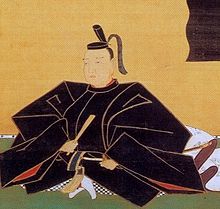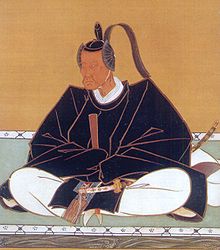Hosokawa clan
| Hosokawa 細川 | |
|---|---|
 The emblem (mon) of the Hosokawa clan | |
| Home province | Various |
| Parent house | |
| Titles | Various |
| Founder | Ashikaga Yoshisue |
| Current head | Morihiro Hosokawa |
| Dissolution | still extant |
| Ruled until | 1947, Constitution of Japan renders titles obsolete |
| Cadet branches | Nagaoka clan Kumamoto Kumamoto-Shinden Udo Hitachi-Yatabe Saikyu clan |
The Hosokawa clan (細川氏, Hosokawa-shi) is a Japanese samurai kin group or clan.[1] The clan descends from the Seiwa Genji, a branch of the Minamoto clan, and ultimately from Emperor Seiwa, through the Ashikaga clan.[2] It produced many prominent officials in the Ashikaga shogunate's administration. In the Edo period, the clan was one of the largest landholding daimyo families in Japan. The current clan head Morihiro Hosokawa served as Prime Minister of Japan.
Muromachi and Sengoku periods
[edit]Ashikaga Yoshisue, son of Ashikaga Yoshizane, was the first to take the surname of Hosokawa. Hosokawa Yoriharu, a Hosokawa of the late Kamakura period, fought for the Ashikaga clan against the Kamakura shogunate. Another, Hosokawa Akiuji, helped establish the Ashikaga shogunate.
The clan wielded significant power over the course of the Muromachi (1336–1467), Sengoku (1467–1600), and Edo periods, moving, however, from Shikoku, to Kinai, and then to Kyūshū over the centuries.
The clan was also one of three families to dominate the post of Kanrei (Shōgun's deputy), under the Ashikaga shogunate. One such individual was Hosokawa Yoriyuki.[3] At the beginning of the Ashikaga's rule, the Hosokawa were given control of the entirety of Shikoku. Over the course of this period, members of the Hosokawa clan were Constables (shugo) of Awa, Awaji, Bitchū, Izumi, Sanuki, Settsu, Tanba, Tosa, and Yamashiro Provinces.

A conflict between Hosokawa Katsumoto, the fifth Kanrei, and his father-in-law Yamana Sōzen, over the shogunate's succession, sparked the Ōnin War, which led to the fall of the shogunate and a period of 150 years of chaos and war, known as the Sengoku period. Following the fall of the Ashikaga shogunate, which was based in Kyoto, control of the city, and thus ostensibly the country, fell into the hands of the Hosokawa clan (who held the post of Kyoto Kanrei – Shōgun's deputy in Kyoto) for a few generations.
Katsumoto's son, Hosokawa Masamoto, held power in this way at the end of the 15th century, but was assassinated in 1507. After his death, the clan became divided and was weakened by internecine fighting. What power they still had, however, was centered in and around Kyoto. This gave them the leverage to consolidate their power to some extent, and came to be strong rivals with the Ōuchi clan, both politically, and in terms of dominating trade with Ming China.[4] The Hosokawa remained in Kyoto for roughly one hundred years, fleeing the city when it was attacked by lord Oda Nobunaga. Another division of the clan whom many believed became extinct is the Saikyū clan (細九氏).
Edo period
[edit]


The Hosokawa of Kokura (later Kumamoto) became the "main" line of the Hosokawa clan during the Edo period. Hosokawa Gracia, the wife of Hosokawa Tadaoki, was one of the most famous samurai converts to Christianity; she was also the daughter of Akechi Mitsuhide.
The Hosokawa sided with Tokugawa Ieyasu against Ishida Mitsunari during the decisive Sekigahara Campaign, and thus were made fudai (inside) daimyō under the Tokugawa shogunate. They were given Higo Province, with an income of 540,000 koku, as their han (fief).
Hosokawa Tadatoshi, the third lord of Kumamoto, was the patron of the artist[5] and swordsman Miyamoto Musashi.[6]
-
Statue of Hosokawa Tadatoshi within Suizen-ji Jōju-en.
-
Though the Hosokawa domain was far from both the shogunate and imperial capital, on Kyūshū, they were among the wealthiest of the daimyōs. By 1750, Higo was one of the top producers of rice, and was in fact counted as a standard by the Osaka rice brokers. The domain suffered from serious economic decline after that, as most domains did, but the sixth lord, Hosokawa Shigekata (1718–1785, r. 1747–1785) instituted a number of reforms which turned the situation around. He also founded a Han school, Jishūkan, in 1755.[8]
In later years, it produced many scholars such as Yokoi Shōnan.
In 1787, the main family line descended from Tadatoshi became extinct with the death of the 7th lord, Shigekata's son Harutoshi (1758–1787; r. 1785–1787). He was succeeded by his distant cousin Narishige, the sixth Lord of Udo (1755–c1835, r. 1787–1810) a direct descendant of Tadatoshi's younger brother Tatsutaka (1615–1645). In 1810, Narishige abdicated his title in favor of his elder son Naritatsu (1788–1826, r. 1810–1826), who succeeded as the ninth lord of Kumamoto. Naritatsu died without an heir in 1826, and was succeeded by his nephew Narimori (1804–1860, r. 1826–1860), the son of Naritatsu's younger brother Tatsuyuki (1784–1818), who was the seventh lord of Udo.[9]
Following the death of Narimori in 1860, his elder son Yoshikuni (1835–1876, r. 1860–1871) succeeded him as the eleventh and final ruling lord of Kumamoto.
There were four major branches of the Hosokawa clan in the Edo period, each of which held the title of daimyō. Another two branches of the family, under the Nagaoka surname, served the Hosokawa of Kumamoto as karō. The residence of one of those families, Hosokawa Gyōbu mansion (細川刑部邸, Hosokawa Gyōbu-tei), is still extant, and is a Tangible Cultural Property of Kumamoto Prefecture.
Boshin War
[edit]During the Boshin War of 1868–69, the Hosokawa of Kumamoto, Kumamoto-Shinden, and Udo sided with the imperial government. Its forces took part in the Battle of Aizu and the Battle of Hakodate, among others.
Meiji and beyond
[edit]Following the abolition of the feudal class in 1871, the Hosokawa clan and its branches were made part of the new nobility in the Meiji era. The head of the main family line (Kumamoto) was given the hereditary title of marquis (kōshaku), while the heads of the secondary branches became viscounts (shishaku); the titles became obsolete in 1947. The present head of the main family line, Morihiro Hosokawa, former Prime Minister of Japan, is a descendant of the Hosokawa of Kumamoto.
Ancestors
[edit]- Emperor Jimmu
- Emperor Suizei
- Emperor Annei
- Emperor Itoku
- Emperor Kōshō
- Emperor Kōan
- Emperor Kōrei
- Emperor Kōgen
- Emperor Kaika
- Emperor Sujin
- Emperor Suinin
- Emperor Keikō
- Yamato Takeru
- Emperor Chūai
- Emperor Ōjin
- Wakanuke Futamata no Kimi
- Ohohoto no Kimi
- Ohi no Kimi
- Ushi no Kimi
- Emperor Keitai
- Emperor Kinmei
- Emperor Bidatsu
- Prince Oshisaka
- Emperor Jomei
- Emperor Tenji
- Prince Shiki
- Emperor Kōnin
- Emperor Kanmu
- Emperor Saga
- Emperor Ninmyō
- Emperor Montoku
- Emperor Seiwa
- Prince Sadazumi
- Minamoto no Tsunemoto
- Minamoto no Mitsunaka
- Minamoto no Yorinobu
- Minamoto no Yoriyoshi
- Minamoto no Yoshiie
- Minamoto no Yoshikuni
- Minamoto no Yoshiyasu
- (Ashikaga) Minamoto no Yoshikiyo
- (Hirosawa) Ashikaga Yoshizane
- (Ashikaga) Hosokawa Yoshisue
Key Genealogies
[edit]Main Branch
[edit]- Hosokawa Yoshisue
- Hosokawa Akiuji (adopted)
- Hosokawa Kimiyori
- Hosokawa Kazuuji (1296–1342)
- Hosokawa Kiyouji (d.1362)
- Hosokawa Yoriyuki
- Hosokawa Yorimoto (1343–1397)
- Hosokawa Mitsumoto (1378–1426)
- Hosokawa Mochimoto (1399–1429)
- Hosokawa Mochiyuki (1400–1442)
- Hosokawa Katsumoto
- Hosokawa Masamoto
- Hosokawa Sumiyuki (1489–1507)
- Hosokawa Sumimoto
- Hosokawa Takakuni
- Hosokawa Tanekuni (1508–1525)
- Hosokawa Harumoto
- Hosokawa Ujitsuna (1514–1564)
- Hosokawa Akimoto (1548–1615)
- Hosokawa Motokatsu (1561–1628)
- Hosokawa Yoshimoto
Kumamoto[10] (Became Main Branch)
- Hosokawa Fujitaka
- Hosokawa Tadaoki
- Hosokawa Tadatoshi
- Hosokawa Mitsunao
- Hosokawa Tsunatoshi (1643–1714)
- Hosokawa Nobunori (1676–1732)
- Hosokawa Munetaka (1716–1747)
- Hosokawa Shigekata
- Hosokawa Harutoshi (1758–1787)
- Hosokawa Narishige (1755–1835)
- Hosokawa Naritatsu (1797–1826)
- Hosokawa Narimori (1804–1860)
- Hosokawa Yoshikuni (1835–1876) – Last ruling Lord of Kumamoto
- Hosokawa Morihisa, 1st Marquis (1839–1893) (created 1884)
- Hosokawa Morishige, 2nd Marquis (1868–1914)
- Hosokawa Moritatsu, 3rd Marquis (title made obsolete in 1947) (1883–1970)
- Hosokawa Morisada, titular 5th Marquis (1912–2005)
- Morihiro Hosokawa, titular 6th Marquis (born 1938)
- Morimitsu Hosokawa, heir (born 1972)
Branches
[edit]Kumamoto-Shinden (Takase)[11]
|
|
|
Udo[12]
|
|
|
|
Hitachi-Yatabe[15]
|
|
|
|
See also
[edit]- Matsui Okinaga
- Miyamoto Musashi
- Kumamoto Castle
- History of Kumamoto Prefecture
- Tōrin-in, former family temple
Notes
[edit]- ^ 細川氏 at Nihon jinmei daijiten; retrieved 2013-5-29.
- ^ Berry, M.E. (1997). The Culture of Civil War in Kyoto, p.45. University of California Press.
- ^ Bodiford, Sōtō Zen in Medieval Japan, p. 129.
- ^ Bingham, A History of Asia, p. 544.
- ^ "Art of Miyamoto Musashi". ecole-miyamoto-musashi.com. 2009. Retrieved August 12, 2020.
- ^ Wilson, The Lone Samurai, pp. 104–105.
- ^ "Mimasaka. Musashi Miyamoto". Mémorial Heiho Niten Ichi Ryu. 2018. Retrieved August 12, 2020.
- ^ Motoyama, Proliferating Talent, pp. 288–289.
- ^ "細川氏(肥後熊本藩主家) - Reichsarchiv ~世界帝王事典~". reichsarchiv.jp. Archived from the original on 13 July 2012. Retrieved 2 February 2022.
- ^ "Hosokawa-shi (Higo Kumamoto hanshu-ke)" Archived 2004-08-10 at the Wayback Machine (ret. 27 September 2008)
- ^ "Hosokawa-shi (Higo Kumamoto-shinden hanshu-ke)" Archived 2004-08-21 at the Wayback Machine (ret. 27 Sept. 2008)
- ^ "Hosokawa-shi (Higo Udo hanshu-ke)" Archived 2004-08-21 at the Wayback Machine (ret. 27 September 2008)
- ^ 細川行孝 at Nihon jinmei daijiten; 細川行孝 at Reichsarchiv.jp; retrieved 2013-5-30.
- ^ 細川立禮 Archived 2013-05-07 at the Wayback Machine at Nihon jinmei daijiten; retrieved 2013-5-30.
- ^ "Hosokawa-shi (Yatabe hanshu-ke)" Archived 2004-08-21 at the Wayback Machine (ret. 27 Sept. 2008)
Further reading
[edit]- Bodiford, William (1993). Sōtō Zen in Medieval Japan. Honolulu: University of Hawaii Press.
- Bingham, Woodbridge (1964). A History of Asia. New York: Allyn and Bacon.
- Motoyama, Yukihiko (1997). Proliferating Talent. Honolulu: University of Hawai'i Press.
- Sansom, George (1961). A History of Japan: 1334-1615. Stanford, California: Stanford University Press.
- Sansom, George (1963). A History of Japan: 1615-1867. Stanford, California: Stanford University Press.
- Wilson, William S. (2004). The Lone Samurai: The Life of Miyamoto Musashi. New York: Kodansha International.
External links
[edit]![]() Media related to Hosokawa clan at Wikimedia Commons
Media related to Hosokawa clan at Wikimedia Commons


![Mon of Miyamoto Musashi born in Ōhara-chō province of Mimasaka.[7]](http://upload.wikimedia.org/wikipedia/commons/thumb/c/c8/Hidari_mitsudomoe.svg/180px-Hidari_mitsudomoe.svg.png)